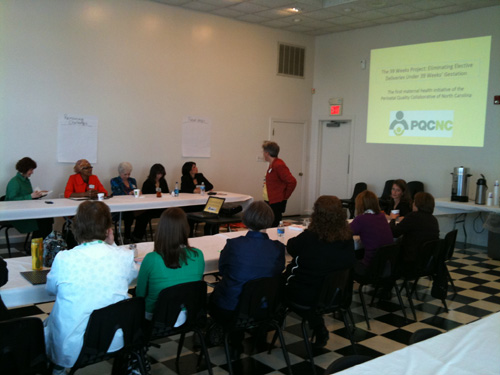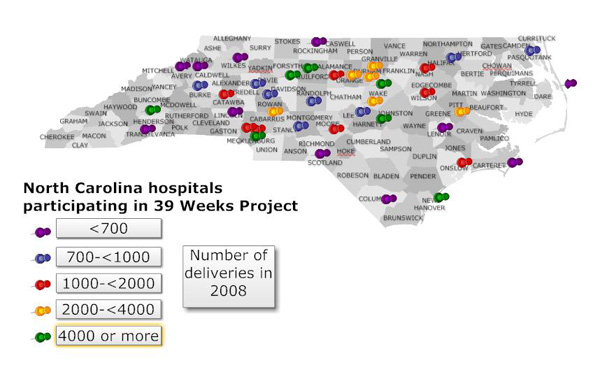On the monthly call this month, criteria for establishing gestational age were reviewed. The "gold standard" for establishing or confirming the EDC is an ultrasound before 20 weeks. Some hospitals are asking both for gestational age and for the criteria used to determine that gestational age when scheduling an induction or repeat c-section that is not medically indicated. Concerns were raised about cases in which a gestational age may have been adjusted later in pregnancy. Many hospitals are now documenting the indication for a planned delivery <39 weeks at the time the delivery is scheduled. Some hospitals have done outreach to the providers who deliver at their facility so that practices will have all needed information when calling the hospital to schedule an induction or c-section.
Updates
On the monthly call this month, criteria for establishing gestational age were reviewed. The "gold standard" for establishing or confirming the EDC is an ultrasound before 20 weeks. Some hospitals are asking both for gestational age and for the criteria used to determine that gestational age when scheduling an induction or repeat c-section that is not medically indicated. Concerns were raised about cases in which a gestational age may have been adjusted later in pregnancy. Many hospitals are now documenting the indication for a planned delivery <39 weeks at the time the delivery is scheduled. Some hospitals have done outreach to the providers who deliver at their facility so that practices will have all needed information when calling the hospital to schedule an induction or c-section.
On the importance of the "Eliminating Elective Deliveries Under 39 Weeks Gestation" Initiative.
Maverick's video has moved - click here to view
In mid-March, half of the teams in the collaborative met either in Hickory or Wilson to discuss areas of success and ongoing challenge while sampling local barbecue. Many teams have made significant progress toward their goals and shared innovative strategies; most teams identifed opportunities for further improvement. Below are some of the ideas shared by teams at the meetings:
- Several hospitals have utilized an existing peer review process or developed one as part of their work on this project to review cases scheduled <39 weeks without medical indication or where the medical indication is not supported by evidence in the chart.
- Labor & Delivery units with dedicated operating rooms have a greater ability to put a "hard stop" on scheduling repeat low transverse c-sections <39 weeks.
- At some hospitals where c-sections are done in the main OR, all c-sections must be cleared by L&D before they are posted by the OR scheduler.
- Physicians report that the March of Dimes brochure "Why the last weeks of pregnancy count" has been a helpful tool when counseling patients about the timing of a scheduled delivery.
- Some hospitals include messages about waiting until 39 weeks for planned deliveries in the patient education materials patients receive early in pregnancy or as part of their marketing videos about their maternity services.




We will hear from maternal fetal medicine specialists and neonatologists affiliated with the PQCNC 39 Weeks Project as well as from the Ohio Perinatal Quality Collaborative. They will address criteria for scheduling delivery <39 weeks for some of the more common indications, such as hypertension and oligohydramnios, the pediatric perspective on increased complications seen in near-term infants, accuracy of gestational ages among scheduled deliveries <39 weeks, and results from the Ohio Collaborative's work since 2008 on reducing elective deliveries <39 weeks. There will also be a quick update of the 39 Weeks Project data showing trends from October 2009 through the end of March 2010.
Click here to access webinar page.
The western regional meeting will be held in Hickory on Tuesday March 16 from 10-1. The eastern regional meeting will take place in Wilson on Wednesday March 17 from 10-1. First quarter data will be reviewed, but the majority of the session will be a “town meeting” where teams can exchange ideas and resources. Please send no more than 3 people from your site; we hope to have as many teams as possible represented and want to keep the group small enough to allow for an interactive session.
During the monthly conference call/webinar this month, each team gave a brief update of their work to date on the 39 Weeks Project. Some teams are continuing to monitor their data and have not tested changes yet, either because their current data suggests their rate of elective delivery <39 weeks is low or because they are examining their data to identify areas for potential change and to engage the physicians and midwives who deliver at these facilities. Other teams have tested changes to how deliveries are scheduled, such as by asking for specific information at the time the case is posted or by designating specific people on the unit who may schedule inductions or c-sections.

